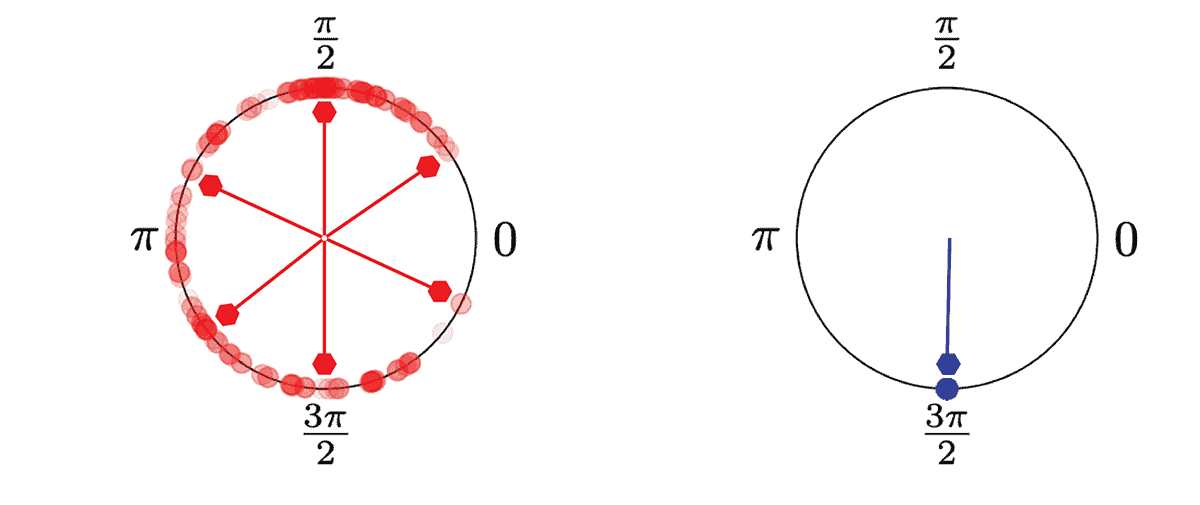
Imagine a big pendulum clock surrounded by several small ones that start ticking at different rhythms. If the clock pendulums are allowed to adjust their rhythms based on those of their neighbours, over time they can synchronize and move in unison with one another. This synchronization process involves two feedback mechanisms: interactions between the identical small clocks and interaction of each small clock with the big, external one.
In the quantum world, however, this co-existence – and the impact of quantum correlations on it – have been largely unexplored. The possible thermodynamic benefits of synchronization in quantum systems have also not been investigated much.
Researchers from the Center for Theoretical Physics of Complex Systems at the Institute for Basic Science, Korea, and the Indian Institute of Technology Bombay, India, recently set out to address this gap. Their work sheds light on how the two synchronization mechanisms – interaction between systems and interactions with a common external source – compete or cooperate when exhibiting thermodynamic behaviour in quantum machines.
Interacting quantum machines
In their study, which they describe in Physical Review Letters, Taufiq Murtadho, Sai Vinjanampathy, and Juzar Thingna consider a set of mutually interacting quantum thermal machines. The machines in question are multilevel quantum systems in contact with a hot and cold reservoir. The most excited level of the system is made up of multiple identical parts with mutual coupling, analogous to the small clocks in the metaphor. To mimic the behaviour of the big clock – a common external unit dragging the system evolution – the machine is also interacting with an external source. Depending on the working regime, this setup can behave as an engine that pumps heat from the hot to the cold reservoir, or as a refrigerator that does the opposite.

The team began by showing that a simple four-level system, interacting with an external source, is sufficient to investigate the interplay of the synchronization mechanisms and its utility for quantum heat engines. Thingna and colleagues then studied what happens to the multiple identical parts in the machine due to the two synchronization mechanisms when the set-up behaves as an engine and when it behaves as a refrigerator.
Notably, they found that the interaction between the individual parts of the machine can produce a symmetric configuration – all parts match rhythms – and an antisymmetric one – all parts do not match rhythms. In contrast, the external source always drags the multiple parts into a symmetric configuration.
Following this thread, the researchers found that in the engine regime, the two mechanisms – mutual interaction and external drive – favour opposing configurations of states. This leads to competition between the two mechanisms. In the refrigerator regime, however, both mechanisms prefer the symmetric configuration and therefore cooperate.
The team then went a step further and showed that in the thermodynamic limit, when the number of multiple individual parts is very large, competition and cooperation between the mechanisms still occurs. However, as the system is scaled up, mutual coupling becomes the dominant mechanism. This leaves the cooperation regime unaffected, but competition, while still present, becomes less relevant in the engine regime.
Thermodynamic gain
Besides uncovering the interplay between the mechanisms, the authors also shed light on how synchronization effects the thermodynamic performance of quantum machines. In a complementary paper published in Physical Review A, the authors illustrate how synchronization can limit the amount of wasteful heat generated. For a working machine, engine or refrigerator, this implies, beyond the well-known Carnot upper bound, a novel lower bound for efficiency.

Quantum mechanics and thermodynamics can both be true, say physicists
According to Thingna and Vinjanampathy, these results will have direct implications for building quantum technologies where external driving and mutual interactions are important. They add that understanding the connections between thermodynamics and different types of synchronization mechanisms in quantum systems will be vital to building and designing energy-efficient machines that operate on thermodynamic principles. This work, they conclude, adds one more piece to the puzzle of the various facets of “quantum” in quantum thermodynamics.
- SEO Powered Content & PR Distribution. Get Amplified Today.
- PlatoData.Network Vertical Generative Ai. Empower Yourself. Access Here.
- PlatoAiStream. Web3 Intelligence. Knowledge Amplified. Access Here.
- PlatoESG. Carbon, CleanTech, Energy, Environment, Solar, Waste Management. Access Here.
- PlatoHealth. Biotech and Clinical Trials Intelligence. Access Here.
- Source: https://physicsworld.com/a/competition-and-cooperation-affect-the-thermodynamic-performance-of-quantum-machines/



